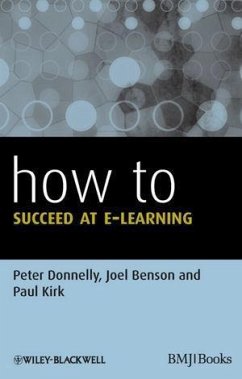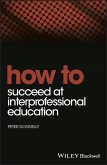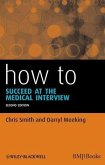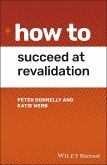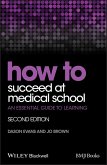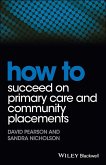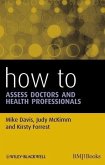37,99 €
37,99 €
inkl. MwSt.
Sofort per Download lieferbar

0 °P sammeln
37,99 €
Als Download kaufen

37,99 €
inkl. MwSt.
Sofort per Download lieferbar

0 °P sammeln
Jetzt verschenken
Alle Infos zum eBook verschenken
37,99 €
inkl. MwSt.
Sofort per Download lieferbar
Alle Infos zum eBook verschenken

0 °P sammeln
- Format: ePub
- Merkliste
- Auf die Merkliste
- Bewerten Bewerten
- Teilen
- Produkt teilen
- Produkterinnerung
- Produkterinnerung

Bitte loggen Sie sich zunächst in Ihr Kundenkonto ein oder registrieren Sie sich bei
bücher.de, um das eBook-Abo tolino select nutzen zu können.
Hier können Sie sich einloggen
Hier können Sie sich einloggen
Sie sind bereits eingeloggt. Klicken Sie auf 2. tolino select Abo, um fortzufahren.

Bitte loggen Sie sich zunächst in Ihr Kundenkonto ein oder registrieren Sie sich bei bücher.de, um das eBook-Abo tolino select nutzen zu können.
A basic guide to getting the best from e-learning for medical students, teachers and all healthcare professionals How to Succeed at e-Learning answers the needs of all healthcare professionals either starting or continuing their studies but not knowing where to begin with e-learning. It is a valuable guide for learners in undergraduate and postgraduate medicine as well as related health professionals and essential for teachers of medicine who are beginning to transfer from print to electronic teaching and need to understand effective methods of presentation.
- Geräte: eReader
- mit Kopierschutz
- eBook Hilfe
- Größe: 2.83MB
Andere Kunden interessierten sich auch für
![How to Succeed at Interprofessional Education (eBook, ePUB) How to Succeed at Interprofessional Education (eBook, ePUB)]() Peter DonnellyHow to Succeed at Interprofessional Education (eBook, ePUB)27,99 €
Peter DonnellyHow to Succeed at Interprofessional Education (eBook, ePUB)27,99 €![How to Succeed at the Medical Interview (eBook, ePUB) How to Succeed at the Medical Interview (eBook, ePUB)]() Chris SmithHow to Succeed at the Medical Interview (eBook, ePUB)31,99 €
Chris SmithHow to Succeed at the Medical Interview (eBook, ePUB)31,99 €![How to Succeed at Revalidation (eBook, ePUB) How to Succeed at Revalidation (eBook, ePUB)]() Peter DonnellyHow to Succeed at Revalidation (eBook, ePUB)35,99 €
Peter DonnellyHow to Succeed at Revalidation (eBook, ePUB)35,99 €![How to Succeed at Medical School (eBook, ePUB) How to Succeed at Medical School (eBook, ePUB)]() Dason EvansHow to Succeed at Medical School (eBook, ePUB)26,99 €
Dason EvansHow to Succeed at Medical School (eBook, ePUB)26,99 €![How to Succeed on Primary Care and Community Placements (eBook, ePUB) How to Succeed on Primary Care and Community Placements (eBook, ePUB)]() David PearsonHow to Succeed on Primary Care and Community Placements (eBook, ePUB)26,99 €
David PearsonHow to Succeed on Primary Care and Community Placements (eBook, ePUB)26,99 €![ABC of Clinical Leadership (eBook, ePUB) ABC of Clinical Leadership (eBook, ePUB)]() Tim SwanwickABC of Clinical Leadership (eBook, ePUB)29,99 €
Tim SwanwickABC of Clinical Leadership (eBook, ePUB)29,99 €![How to Assess Doctors and Health Professionals (eBook, ePUB) How to Assess Doctors and Health Professionals (eBook, ePUB)]() Mike DavisHow to Assess Doctors and Health Professionals (eBook, ePUB)31,99 €
Mike DavisHow to Assess Doctors and Health Professionals (eBook, ePUB)31,99 €-
-
-
A basic guide to getting the best from e-learning for medical students, teachers and all healthcare professionals How to Succeed at e-Learning answers the needs of all healthcare professionals either starting or continuing their studies but not knowing where to begin with e-learning. It is a valuable guide for learners in undergraduate and postgraduate medicine as well as related health professionals and essential for teachers of medicine who are beginning to transfer from print to electronic teaching and need to understand effective methods of presentation.
Dieser Download kann aus rechtlichen Gründen nur mit Rechnungsadresse in D ausgeliefert werden.
Produktdetails
- Produktdetails
- Verlag: Wiley
- Erscheinungstermin: 25. Mai 2012
- Englisch
- ISBN-13: 9781118308479
- Artikelnr.: 37352508
- Verlag: Wiley
- Erscheinungstermin: 25. Mai 2012
- Englisch
- ISBN-13: 9781118308479
- Artikelnr.: 37352508
- Herstellerkennzeichnung Die Herstellerinformationen sind derzeit nicht verfügbar.
Peter Donnelly MB, BCh, BAO, FRCPysch, BA (Open), Deputy Dean, Wales Deanery, Cardiff University, Cardiff, UK
Paul Kirk BSc (Hons), MSc, PGCert Ed., E.Learning Unit Development Manager, Wales Deanery, Cardiff University, Cardiff, UK
Joel Benson BA (Hons), PGC (ODL), Electronic Resources Officer, Wales Deanery, Cardiff University, Cardiff, UK
Paul Kirk BSc (Hons), MSc, PGCert Ed., E.Learning Unit Development Manager, Wales Deanery, Cardiff University, Cardiff, UK
Joel Benson BA (Hons), PGC (ODL), Electronic Resources Officer, Wales Deanery, Cardiff University, Cardiff, UK
Acknowledgements ix
Chapter 1: Introduction 1
1.1 Overview of the book 1
1.2 Basic issues 1
1.3 Challenges as drivers 2
1.4 The start of technology in learning 2
Reference 4
Chapter 2: E-learning . . . what is it? 5
2.1 Definitions 5
2.2 Advantages of e-learning 24
References 26
Chapter 3: Evidence e-learning works 29
3.1 Systematic reviews 29
3.2 Examples of subject-specific studies (categorised by profession) 33
3.3 Summary of findings 36
3.4 Conclusion 37
References 37
Chapter 4: Using e-learning to teach 41
4.1 Requirement 42
4.2 Exploration 54
4.3 The course 63
4.4 The assessment 66
4.5 Choosing a platform 67
4.6 Summary 68
References 68
Chapter 5: Access to e-learning 71
5.1 The basics: files and folders 71
5.2 Security 72
5.3 The book and the browser 73
5.4 Collaborative research 76
References 80
Chapter 6: Examples of technology in use 83
6.1 A Taste of Medicine 83
6.2 Examples of innovative e-learning from developing countries 85
6.3 Examples from developed countries 92
References 93
Chapter 7: E-learning qualifications 95
7.1 What to look for in an online course 96
7.2 Clinical courses 98
7.3 Leadership courses 106
7.4 Management courses 109
7.5 General information on internationally available online MBAs 113
7.6 Mentoring courses 114
7.7 Legal courses 117
References 120
Chapter 8: Research 123
8.1 Just in time just enough and on the move 123
8.2 What is virtual reality (VR)? 124
8.3 Virtual reality systems in medicine 125
8.4 VR in obstetrics and gynaecology 125
8.5 Life-size patient simulators 127
8.6 Other simulation examples 128
8.7 Whole-heart modelling 129
8.8 Telling stories: understanding real-life genetics 129
8.9 Second Life VR 129
References 133
Chapter 9: Looking towards the future 135
9.1 The recent past 135
9.2 Why is 'computing power' important and how is it defined? 137
9.3 Past trends informing future trends 137
9.4 Experiments involving neurosurgical implants 139
9.5 Ongoing development in mobile technology 140
9.6 Summary 141
References 141
Chapter 10: Conclusion 143
Index 147
Chapter 1: Introduction 1
1.1 Overview of the book 1
1.2 Basic issues 1
1.3 Challenges as drivers 2
1.4 The start of technology in learning 2
Reference 4
Chapter 2: E-learning . . . what is it? 5
2.1 Definitions 5
2.2 Advantages of e-learning 24
References 26
Chapter 3: Evidence e-learning works 29
3.1 Systematic reviews 29
3.2 Examples of subject-specific studies (categorised by profession) 33
3.3 Summary of findings 36
3.4 Conclusion 37
References 37
Chapter 4: Using e-learning to teach 41
4.1 Requirement 42
4.2 Exploration 54
4.3 The course 63
4.4 The assessment 66
4.5 Choosing a platform 67
4.6 Summary 68
References 68
Chapter 5: Access to e-learning 71
5.1 The basics: files and folders 71
5.2 Security 72
5.3 The book and the browser 73
5.4 Collaborative research 76
References 80
Chapter 6: Examples of technology in use 83
6.1 A Taste of Medicine 83
6.2 Examples of innovative e-learning from developing countries 85
6.3 Examples from developed countries 92
References 93
Chapter 7: E-learning qualifications 95
7.1 What to look for in an online course 96
7.2 Clinical courses 98
7.3 Leadership courses 106
7.4 Management courses 109
7.5 General information on internationally available online MBAs 113
7.6 Mentoring courses 114
7.7 Legal courses 117
References 120
Chapter 8: Research 123
8.1 Just in time just enough and on the move 123
8.2 What is virtual reality (VR)? 124
8.3 Virtual reality systems in medicine 125
8.4 VR in obstetrics and gynaecology 125
8.5 Life-size patient simulators 127
8.6 Other simulation examples 128
8.7 Whole-heart modelling 129
8.8 Telling stories: understanding real-life genetics 129
8.9 Second Life VR 129
References 133
Chapter 9: Looking towards the future 135
9.1 The recent past 135
9.2 Why is 'computing power' important and how is it defined? 137
9.3 Past trends informing future trends 137
9.4 Experiments involving neurosurgical implants 139
9.5 Ongoing development in mobile technology 140
9.6 Summary 141
References 141
Chapter 10: Conclusion 143
Index 147
Acknowledgements ix
Chapter 1: Introduction 1
1.1 Overview of the book 1
1.2 Basic issues 1
1.3 Challenges as drivers 2
1.4 The start of technology in learning 2
Reference 4
Chapter 2: E-learning . . . what is it? 5
2.1 Definitions 5
2.2 Advantages of e-learning 24
References 26
Chapter 3: Evidence e-learning works 29
3.1 Systematic reviews 29
3.2 Examples of subject-specific studies (categorised by profession) 33
3.3 Summary of findings 36
3.4 Conclusion 37
References 37
Chapter 4: Using e-learning to teach 41
4.1 Requirement 42
4.2 Exploration 54
4.3 The course 63
4.4 The assessment 66
4.5 Choosing a platform 67
4.6 Summary 68
References 68
Chapter 5: Access to e-learning 71
5.1 The basics: files and folders 71
5.2 Security 72
5.3 The book and the browser 73
5.4 Collaborative research 76
References 80
Chapter 6: Examples of technology in use 83
6.1 A Taste of Medicine 83
6.2 Examples of innovative e-learning from developing countries 85
6.3 Examples from developed countries 92
References 93
Chapter 7: E-learning qualifications 95
7.1 What to look for in an online course 96
7.2 Clinical courses 98
7.3 Leadership courses 106
7.4 Management courses 109
7.5 General information on internationally available online MBAs 113
7.6 Mentoring courses 114
7.7 Legal courses 117
References 120
Chapter 8: Research 123
8.1 Just in time just enough and on the move 123
8.2 What is virtual reality (VR)? 124
8.3 Virtual reality systems in medicine 125
8.4 VR in obstetrics and gynaecology 125
8.5 Life-size patient simulators 127
8.6 Other simulation examples 128
8.7 Whole-heart modelling 129
8.8 Telling stories: understanding real-life genetics 129
8.9 Second Life VR 129
References 133
Chapter 9: Looking towards the future 135
9.1 The recent past 135
9.2 Why is 'computing power' important and how is it defined? 137
9.3 Past trends informing future trends 137
9.4 Experiments involving neurosurgical implants 139
9.5 Ongoing development in mobile technology 140
9.6 Summary 141
References 141
Chapter 10: Conclusion 143
Index 147
Chapter 1: Introduction 1
1.1 Overview of the book 1
1.2 Basic issues 1
1.3 Challenges as drivers 2
1.4 The start of technology in learning 2
Reference 4
Chapter 2: E-learning . . . what is it? 5
2.1 Definitions 5
2.2 Advantages of e-learning 24
References 26
Chapter 3: Evidence e-learning works 29
3.1 Systematic reviews 29
3.2 Examples of subject-specific studies (categorised by profession) 33
3.3 Summary of findings 36
3.4 Conclusion 37
References 37
Chapter 4: Using e-learning to teach 41
4.1 Requirement 42
4.2 Exploration 54
4.3 The course 63
4.4 The assessment 66
4.5 Choosing a platform 67
4.6 Summary 68
References 68
Chapter 5: Access to e-learning 71
5.1 The basics: files and folders 71
5.2 Security 72
5.3 The book and the browser 73
5.4 Collaborative research 76
References 80
Chapter 6: Examples of technology in use 83
6.1 A Taste of Medicine 83
6.2 Examples of innovative e-learning from developing countries 85
6.3 Examples from developed countries 92
References 93
Chapter 7: E-learning qualifications 95
7.1 What to look for in an online course 96
7.2 Clinical courses 98
7.3 Leadership courses 106
7.4 Management courses 109
7.5 General information on internationally available online MBAs 113
7.6 Mentoring courses 114
7.7 Legal courses 117
References 120
Chapter 8: Research 123
8.1 Just in time just enough and on the move 123
8.2 What is virtual reality (VR)? 124
8.3 Virtual reality systems in medicine 125
8.4 VR in obstetrics and gynaecology 125
8.5 Life-size patient simulators 127
8.6 Other simulation examples 128
8.7 Whole-heart modelling 129
8.8 Telling stories: understanding real-life genetics 129
8.9 Second Life VR 129
References 133
Chapter 9: Looking towards the future 135
9.1 The recent past 135
9.2 Why is 'computing power' important and how is it defined? 137
9.3 Past trends informing future trends 137
9.4 Experiments involving neurosurgical implants 139
9.5 Ongoing development in mobile technology 140
9.6 Summary 141
References 141
Chapter 10: Conclusion 143
Index 147
